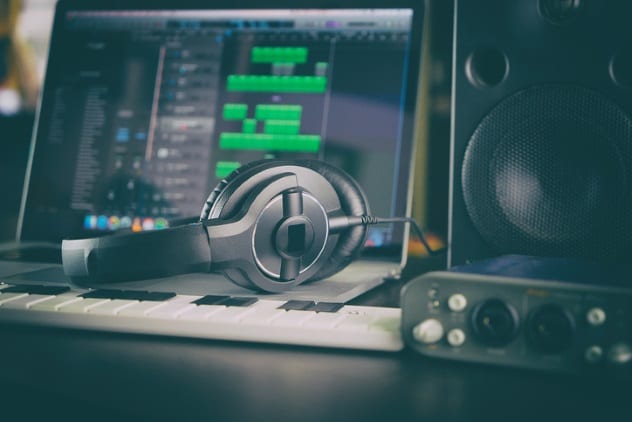 Mysteries
Mysteries  Mysteries
Mysteries  History
History 10 Surprising Stories About the Texas Rangers
 Humans
Humans 10 Philosophers Who Were Driven Mad by Their Own Theories
 Miscellaneous
Miscellaneous 10 Video-Game-Worthy Weapons and Armors from History
 Weird Stuff
Weird Stuff 10 Psychics Who Accurately Predicted Wartime Events
 The Arts
The Arts 10 Pieces of Art Inspired by a Broken Heart
 Health
Health 10 Science Fiction-Sounding New Medical Treatments
 History
History 10 Surprising Facts About the Father of Submarine Warfare
 Space
Space Ten Astonishing New Insights into Alien Worlds
 Weird Stuff
Weird Stuff 10 Bizarre Summer Solstice Rituals Still Practiced Today
 Mysteries
Mysteries Top 10 Haunting Facts About the Ghost Ship MV Alta
 History
History 10 Surprising Stories About the Texas Rangers
 Humans
Humans 10 Philosophers Who Were Driven Mad by Their Own Theories
Who's Behind Listverse?

Jamie Frater
Head Editor
Jamie founded Listverse due to an insatiable desire to share fascinating, obscure, and bizarre facts. He has been a guest speaker on numerous national radio and television stations and is a five time published author.
More About Us Miscellaneous
Miscellaneous 10 Video-Game-Worthy Weapons and Armors from History
 Weird Stuff
Weird Stuff 10 Psychics Who Accurately Predicted Wartime Events
 The Arts
The Arts 10 Pieces of Art Inspired by a Broken Heart
 Health
Health 10 Science Fiction-Sounding New Medical Treatments
 History
History 10 Surprising Facts About the Father of Submarine Warfare
 Space
Space Ten Astonishing New Insights into Alien Worlds
 Weird Stuff
Weird Stuff 10 Bizarre Summer Solstice Rituals Still Practiced Today
Top 10 Musical Instruments Of Tomorrow
Music has been a part of human life since time immemorial. It penetrates our souls and becomes a part of us, just as we, its creators, are a part of it. We and our creations grow and learn together, and each phase of human development brings with it new tools to create the aural extension of our soul.
The future will be no different. As we progress into the horizon of time, these ten instruments of tomorrow will sing the soundtrack of our ascension.
10 Pocket Synths
As music technology advances, the production of music and musical instruments becomes more accessible, more affordable, and more casual. The need for massive studio setups, at least below the highest professional echelons of the industry, is rapidly dwindling in favor of simplicity and the capacity to create and display music casually and on the fly. Enter: pocket synths.
These compact yet versatile systems for the creation of music are a perfect fit for the needs of tomorrow’s aspiring musicians. Models like the Korg Volka and even models by Teenage Engineering that cost as little as $49 are giving modern songsmiths all the tools they need in a pocket-size package at a fraction of the price of the typical studio and stage synths that are much more expensive and much less convenient.[1]
And, if the simplicity of pocket synths is, for some reason, still too much for you, there are the wearable triggers made by DrumPants, which integrate with your clothes to allow you to create drumbeats simply by tapping your lap and stamping your feet, just like you already do to your favorite tunes, anyway!
9 Enhanced Guitars
Guitars have been a mainstay of music since their invention, through the creation of the first electric versions, and into the present day, with recent advancements like extended-range models (seven-, eight-, nine-string, etc.) and the synth pickup. Given the continuing relevance of this instrument, it’s safe to say that it won’t be disappearing anytime soon. How, though, will they manage to remain relevant in the ever-changing landscape of modern music? The same way they always have: by adapting and advancing. Any of the older versions of the guitar could be included in this list, but the way they are used in most music is the same as it always has been, so we’ll focus on the guitars of the future.
The aforementioned synth pickups in particular allow guitars a level of sound control generally reserved for synthesizers, and Boss’s GK series even allows for the articulation of electric guitar—the trait that gives instruments their ability to create feeling, and a trait for which electric guitar is particularly renowned—to be utilized with synthesized sounds, which are usually especially lacking in this regard.[2] Additional add-ons, fringe components, and various other Frankenstein-esque technologies are constantly in development, assuring that this instrumental mainstay is here for the long haul.
8 Digital Simulated Instruments
Much like the synth pickup guitars mentioned above, many other instruments are attempting to modernize through digitization. Electric versions of classical strings, for example, are readily available, and electronic wind instruments feature the ability to simulate various wind and brass instruments with a single interface. (These instruments are usually all played differently and require separate training.)
Perhaps the most prevalent of these digitized classics is the electronic drum kit. Acoustic kit drums are not particularly versatile in their sound, regularly replaced by electronic versions in professional recordings, difficult to transport, and a nightmare to record (despite the fact that they will likely be mostly dubbed over regardless). Electronic drums, however, feature a wide variety of sounds (both acoustic-sounding and synthy) which are performance- and recording-ready and are far more convenient for both recording and travel, not to mention the adjustable volume which allows you to play and practice—even late at night—without making mortal enemies of your roommates and neighborhood.[3]
7 Pan Drums
One type of preexisting instrument that requires no technological advancement to survive the progress of the musical world is the pan drum. In fact, one type of pan drum—called the tongue drum—is thought to be the most ancient instrument besides the voice! Some African cultures even have a language developed for them. So if that’s the case, then why is it that these instruments are featured on a list of the instruments of tomorrow?
There are actually a few collected reasons that keep pan drums relevant and even presently rising in popularity:
Firstly, pan drums are easy to learn and play, making them accessible to beginners and those intimidated by the perceived difficulty of learning a musical instrument.[4]
Second, they are convenient. As stated above, they do not require the additional accessories, particularly amplifiers and other electronic elements, making them easy to carry and perform publicly and on the fly. This is often done by even the most notable of lap drum artists, such as Hang Massive.
Third, and possibly most importantly, the etheric and almost psychedelic sound created by pan drums is strikingly dynamic and complex for an acoustic instrument. The sound is otherworldly and speaks to a primal part of the soul which is as ancient as the instrument itself. This naturally mystical tone conjures a dreaminess unparalleled by even most synthetically created and richly layered musical sounds.
6 Nomis
The main pitfall of DJing and performing other forms of loop-oriented music is the lack of showmanship of performing the utilized instruments. Well, for those in the loop world looking to up the performance ante, the Nomis by Jonathan Sparks is here to answer the call in a fantastically theatrical fashion.
The Nomis features a flashy, vertical octagonal controller framing the person playing it. This controller is flanked by two lighted towers. The first towers displays a color representing the sound being used. A rotation of the large octagonal controller loops the melody played and activates a similar light on the second tower which pulses as the looped notes play, not only creating an amazing light show but also allowing the audience a detailed look at the essence of the music they are enjoying.[5] This engrossing display of electronic musicianship is sure to bring the art of electronic music performance headlong into tomorrow.
5 Expressive Synths
Expression and articulation are shortcomings of synthesized instruments, as well as keyboard-based instruments in general. The keys of a piano cannot be bent like the strings of a guitar, and even the digital bending and expressive features of a synthesizer pale in comparison to those of a string or wind instrument played with all the infinite subtlety and detail of precise, articulate human movement and the natural dynamics of a real-world vibrating instrument.
There are, however, various new models of synthesizer that are challenging this notion and increasing the degree of detailed expression in digital instruments dramatically. Take, for example, the Continuum Fingerboard; a synthesizer featuring a flat, rectangular surface with evenly spaced notes—similar to the keys on a keyboard but digitally projected—on which the finger can slide and move to generate expressions such as pitch-bending and dynamic touch sensitivity based on pressure and other intricate elements of human touch.[6] The ROLI Seaboard features similar dynamic traits but is controlled by flexible silicon rubber keys. There are also various other options for expressive keyboard synthesizers and even drum machine-style synthesizers which feature similar dynamic touch controls to the aforementioned keyboard versions.
4 Metatonals
Imagine you were told that literally every piece of music you’ve ever heard, save for a cappella and a small, select collection of horns and fretless string instruments, was played incorrectly, or at least inaccurately. Would you believe it? Well, you should, because it’s the truth, and here to prove it, as well as to correct the mistakes, is a collection of instruments referred to as “metatonals.”
Music is a much more complex science than the vast majority of people realize. The precise pitch of a note varies depending on the notes with which it is resonating. For example, a G-sharp on its own is a slightly different pitch than a G-sharp resonating with an E, and those are different than if they were resonating with different notes, and so on. No instrument with notes in controlled locations, such as with the keys of a keyboard or the frets of a guitar, can match these minute variations accurately and thus settle for roundabout pitches that resonate well together but not perfectly in each context.
Additionally, there are many intervals at which resonant notes can be organized. The standard set used collectively as a standard by modern musicians (known as diatonic) is only one of an infinite set of choices, picked for the sake of uniformity of instruments and the ability for musicians to communicate.[7] After all, if instruments didn’t share the same notes, they wouldn’t be able to play together, and their players wouldn’t be learning and understanding the same information.
As instrumental technologies advance, however, the ability is growing within them to have more options to make them more versatile in their types of resonance and more precise within the keys and context in which they are being played. There are various new technologies, including removable and/or adjustable fretboards as well as fretboards with different spacing that allow guitars and basses more versatility.
Most significant of the metatonal instruments, however, is likely the Tonal Plexus, a keyboard-like instrument featuring a massive amount of intervals in between each standard musical note, making for a virtually unlimited set of keys and the precise ability to harmonize notes for any context. Instruments like these not only explode the amount of potential melodies and other tonal elements that a musician can use but also make the music we already love sound significantly better, both increasing creative options and making all music sound better at its foundation.
3 Eigenharp
One of the most important elements of the future of musical instruments is convenient versatility. This is plainly evident in the rise of synthesizers as opposed to singular instruments, which have greater dynamics, expression, and articulation (though, as stated in items above, synthetic instruments are rapidly catching up). The Eigenharp is perhaps the greatest example of this notion.
Combining the features of synthesizers, drum machines, and sequencers in an instrument that can be played similarly to a guitar, keyboard, a wind instrument, or some custom hybridization of those and with expression in both the fingers and the “breath pipe” (the feature which allows wind-style playing), this instrument is the ultimate in versatility and expression. Not only that, but the guitar-style playing position of the instrument makes it ideal for live performances as well. The Eigenharp is the ultimate all-purpose instrument.[8]
2 Bioinstruments
Okay, time to get wild. What if the human body itself was included on this list? One would likely assume that this means singing, perhaps beatboxing, maybe even ham-bone, but that’s not it at all. Granted, these things are not going to disappear by any means, but as they also aren’t likely to change dramatically in the way they are used, it would be imprudent to have them take up extra space on this list. What this item represents is, in fact, none of these things but rather technologies that are used to collect signals from the natural functions of the body, such as the heart and brain, to create music. Sound confusing? Let’s frame it this way:
What if you could think music and make it happen? Seriously.
The encephalophone is a device that converts brain waves into musical signals. This fantastically inventive instrument is a revolutionary way to express the music imagined by a musician regardless of technical instrumental talent and academics. Research is also being done to use this amazing tool to help musicians suffering from some form of injury or ailment that prevents them from singing or interacting with a musical instrument to be able to create music despite their condition.
In addition to the encephalophone, there is also a device called the cardiophone, which uses the heartbeat to generate rhythmic tones for either musical or medical monitoring purposes.[9] Clearly, the human body is one of the emerging musical instruments of our time.
1 Computers

Perhaps this item seems like a bit of a cop-out, but the necessity of computers to the future of music is undeniable. Every item on this list requires a computer to operate, save for the pan drum, which still requires a computer to be recorded (unless you consider more outdated recording methods, like tape or wax, but these methods are largely abandoned except for in certain enthusiast circles). Recordings on computer can also be manipulated and fine-tuned in a seemingly infinite collection of ways in order to make a piece of music into precisely the form imagined by its creator.
Additionally, computers can be used to manually enter musical information into a program, bypassing the need for another instrument entirely.[10] There is no doubt that the computer is the most quintessential piece of musical equipment for now and into the foreseeable future.
The music that will resonate through our own futures and the lives our children is unforeseeable. We may, however, get a taste of the sound through the instruments on which the songs will be written, and if the tools listed above are any indication, the sound will be most wondrous.
Jason Karras writes, therefore he is.
Read about more amazing and unique musical instruments on 10 Weirdest Musical Instruments and 10 Bizarre Versions Of Musical Instruments.








